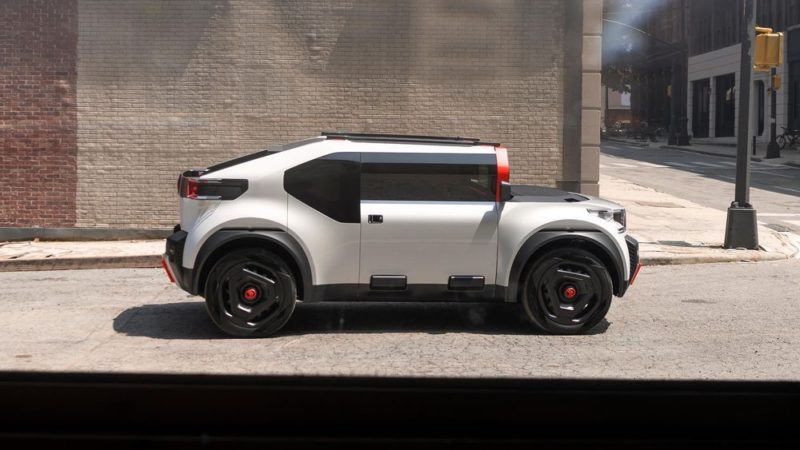Citroën is taking weight loss to extremes with its new concept car Oli, jettisoning door speakers, cutting down on glass, and swapping out steel for cardboard, in a bid to create a more sustainable, more affordable EV.
The company says it’s “bucking industry trends” towards bigger vehicles by cutting the electric ute weight down to 1000kg in order to deliver a 400km range on energy consumption of 10kWh/100km from a mini 40 kWh battery.
Stripping out the weight has created major design implications for the Mars Rover-like city car, which will have a top speed of 110km/h.
The flat bonnet, roof and ute tray create a boxy silhouette and are made from recycled corrugated cardboard, a material already popular for making beds and increasingly interesting to architects for buildings, which are reinforced with fibreglass.

Citroën says the panels are strong enough for an adult to stand on them — or bike racks or roof boxes — and are half the weight of steel.
The flat lines of the roof and side panels are matched by the windscreen, which is vertical instead of the usual curved glass. The flat panel means less glass is used, but less glass is also used over all as well: a detail that will be a curse for reversing but which Citroën says reduced sunlight entering the cab means less need for aircon, lowering that tax on the battery by as much as 17 per cent.
“You could argue a vertical screen is less aerodynamic, but we don’t expect people to drive this kind of vehicle at 200 km/h,” says Pierre Sabas, head of Citroën Advanced Design and Concept Vehicles.
“We see it being most useful in urban and suburban areas where people reduce speed and are aware of the environmental and safety aspects of everyday mobility. That is why we have limited oli’s top speed to a maximum of 110km/h.”
The seats have been stripped back and look more like a bright red office chair, made with recyclable materials, naturally, and entertainment is strictly BYO with a projector screen, bluetooth and speaker docks carving another 250g from the weight.

In a bid for the family market, Citroën has added drain plugs to the floor similar to those you’d find in a boat, making it possible to remove the interior foam and hose it down after a trip to the beach or simply to remove layers of detritus created by children.
The ute also features flip-up door windows and 20-inch steel and aluminium wheels, which are less energy intensive to make than regular wheels and which GoodYear says can boost tyre lifespan to 10 times the recommended length of most road tyres.
Citroën has not said when the Oli will be put into production and unfortunately for Australians who are partial to the French company’s new styling, the company does not sell its cars here.


Rachel Williamson is a science and business journalist, who focuses on climate change-related health and environmental issues.

